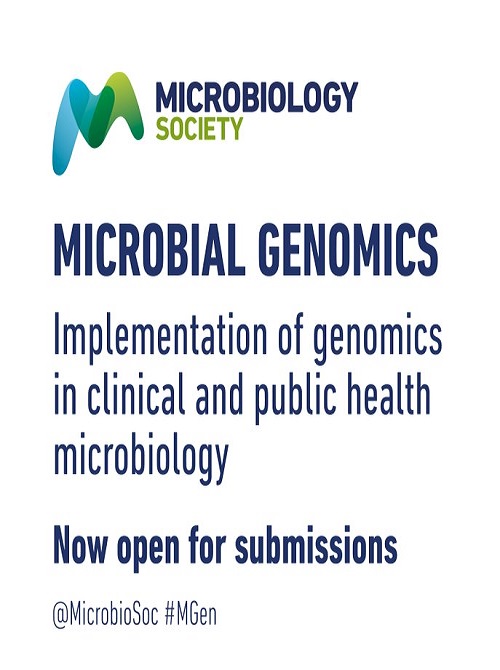生态学影响食虫蝙蝠链霉菌的基因组和生物合成多样化
IF 4
2区 生物学
Q1 GENETICS & HEREDITY
引用次数: 0
摘要
链霉菌是一种多产的次级代谢产物生产者,许多临床上有用的化合物都是从链霉菌中提取的。它们栖息于不同的栖息地,但在脊椎动物中却鲜有报道。在此,我们旨在确定生态来源(蝙蝠宿主物种和洞穴地点)对链霉菌基因组和生物合成多样性的影响程度。我们分析了从美国亚利桑那州和新墨西哥州六个洞穴地点的 11 种食虫性蝙蝠中采样的 132 个链霉菌分离物的基因组草案。根据全基因组平均核苷酸同一性和核心基因组系统发生树,我们划分出 55 个物种。与来自其他蝙蝠种类或栖息地的链霉菌相比,定殖于同一蝙蝠种类或栖息于同一地点的链霉菌分离物表现出更大的整体基因组相似性。不过,如果只考虑生物合成基因簇(BGC),BGC 的分布结构并不取决于携带这些基因簇的链霉菌的生态或地理来源。每个基因组携带 19–65 个 BGCs(中位数=42.5),即使是同一链霉菌种的成员之间也存在差异。在 11 个蝙蝠物种中的 10 个物种和所有位点都检测到了九大类 BGC:萜烯、非核糖体肽合成酶、多酮合成酶、苷元、类 RiPP、丁内酯、兰肽、外肽、黑色素。最后,链霉菌基因组携带多个混合 BGC,由来自 2 到 7 个不同 BGC 类别的特征结构域组成。综上所述,我们的研究结果为了解链霉菌-蝙蝠生态学和 BGC 多样性提供了重要的启示,这可能有助于蝙蝠的健康,也有助于加强目前的天然产品发现工作,特别是从未充分开发或被忽视的环境中发现天然产品。本文章由计算机程序翻译,如有差异,请以英文原文为准。
Ecology shapes the genomic and biosynthetic diversification of Streptomyces bacteria from insectivorous bats
Streptomyces are prolific producers of secondary metabolites from which many clinically useful compounds have been derived. They inhabit diverse habitats but have rarely been reported in vertebrates. Here, we aim to determine to what extent the ecological source (bat host species and cave sites) influence the genomic and biosynthetic diversity of Streptomyces bacteria. We analysed draft genomes of 132 Streptomyces isolates sampled from 11 species of insectivorous bats from six cave sites in Arizona and New Mexico, USA. We delineated 55 species based on the genome-wide average nucleotide identity and core genome phylogenetic tree. Streptomyces isolates that colonize the same bat species or inhabit the same site exhibit greater overall genomic similarity than they do with Streptomyces from other bat species or sites. However, when considering biosynthetic gene clusters (BGCs) alone, BGC distribution is not structured by the ecological or geographical source of the Streptomyces that carry them. Each genome carried between 19–65 BGCs (median=42.5) and varied even among members of the same Streptomyces species. Nine major classes of BGCs were detected in ten of the 11 bat species and in all sites: terpene, non-ribosomal peptide synthetase, polyketide synthase, siderophore, RiPP-like, butyrolactone, lanthipeptide, ectoine, melanin. Finally, Streptomyces genomes carry multiple hybrid BGCs consisting of signature domains from two to seven distinct BGC classes. Taken together, our results bring critical insights to understanding Streptomyces-bat ecology and BGC diversity that may contribute to bat health and in augmenting current efforts in natural product discovery, especially from underexplored or overlooked environments.
求助全文
通过发布文献求助,成功后即可免费获取论文全文。
去求助
来源期刊

Microbial Genomics
Medicine-Epidemiology
CiteScore
6.60
自引率
2.60%
发文量
153
审稿时长
12 weeks
期刊介绍:
Microbial Genomics (MGen) is a fully open access, mandatory open data and peer-reviewed journal publishing high-profile original research on archaea, bacteria, microbial eukaryotes and viruses.
 求助内容:
求助内容: 应助结果提醒方式:
应助结果提醒方式:


